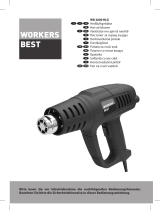11
Napominjemo da naša oprema nije proizvedena za ko-
mercijalnu, trgovačku ili industrijsku primjenu. Jamstvo
neće biti valjano ako opremu koristite u komercijalne
svrhe, za trgovačke ili industrijske poslovne djelatnosti
ili u slične svrhe.
5. Sigurnosne napomene
m Pozor! Prilikom uporabe električnog alata mora-
te se pridržavati sljedećih osnovnih mjera sigurnosti
radi zaštite od električnog udara i smanjenja rizika od
ozljede i požara. Pročitajte sve obavijesti navedene u
nastavku prije korištenja električnog alata i sačuvajte
upute o sigurnosti za buduću uporabu.
m Pozor! Prilikom korištenja kompresora treba se
pridržavati sljedećih osnovnih sigurnosnih mjera za
zaštitu od električnog udara, ozljeda i požara. Prije ne-
go što počnete koristiti uređaj, pročitajte i pridržavajte
se ovih napomena.
1 Radno područje održavajte urednim
– Neuredno radno područje može uzrokovati nez-
gode.
2 Uzmite u obzir utjecaje iz okoline
– Električni alat nemojte izlagati utjecaju kiše.
– Električni alat nemojte koristiti u vlažnom ili mo-
krom okruženju. Postoji opasnost od električnog
udara!
– Pobrinite se da radno područje bude dovoljno
osvijetljeno.
– Električni alat nemojte koristiti ondje gdje postoji
opasnost od požara ili eksplozije.
3 Zaštitite se od električnog udara
– Izbjegavajte tjelesne dodire s uzemljenim dije-
lovima (npr. cijevima, radijatorima, električnim
štednjacima, uređajima za hlađenje).
4 Udaljite djecu od mjesta rada
– Ne dozvolite da druge osobe dodiruju opremu ili
kabel, udaljite ih od radnog područja.
5 Na siguran način pohranite električni alat koji se ne
koristi
– Električni alat koji se ne koristi pohranite na suho,
podignuto ili zatvoreno mjesto, izvan dohvata
djece.
6 Ne preopterećujte električni alat
– Alat radi bolje i sigurnije u propisanom rasponu
opterećenja.
7 Nosite prikladnu odjeću
– Nemojte nositi široku odjeću ili nakit jer ih mogu
zahvatiti pokretni dijelovi.
– Prilikom rada na otvorenom preporučuje se
korištenje protuklizne obuće i gumenih rukavica.
– Svežite dugu kosu u zaštitnu mrežu za kosu.
8 Nemojte koristiti kabel za svrhe za koje nije
predviđen.
– Nemojte izvlačiti kabel iz utičnice povlačeći ga
za utikač. Kabel zaštitite od topline, ulja i oštrih
rubova.
9 Vodite brigu o alatu
– Održavajte kompresor čistim kako bi radio isp-
ravno i sigurno.
– Pridržavajte se uputa za održavanje.
– Redovito provjeravajte priključni kabel
električnog alata i u slučaju oštećenja, odnesite
ga stručnoj osobi radi zamjene.
– Redovito pregledavajte produžne kablove i zami-
jenite ih u slučaju oštećenja.
10 Izvucite utikač iz utičnice
– Kada ne koristite električni alat ili prije
održavanja i prilikom zamjene nastavaka kao što
su listovi pile, svrdla, glave za glodanje
11 Izbjegavajte nehotično pokretanje
– Pobrinite se da sklopka bude isključena prilikom
priključenja utikača u utičnicu.
12 Upotrebljavajte produžne kablove za vanjsku
uporabu
– Za uporabu na otvorenom koristite samo atesti-
rane i propisno označene kablove.
– Kablove na kolutu koristite samo kada su odmo-
tani.
13 Budite pažljivi
– Budite usredotočeni na ono što radite. Pri
radu postupajte s osjećajem. Nemojte koristiti
električni alat ako niste usredotočeni.
14 Provjerite je li električni alat oštećen
– Prije kontinuirane uporabe električnog alata
pažljivo pregledajte zaštitne uređaje i ostale dije-
love kako biste se uvjerili da nisu neispravni te da
rade na predviđeni način.
– Provjerite rade li pokretni dijelovi rade bez greške
i da nisu zaglavljeni ili oštećeni. Kako biste
osigurali rad električnog alata bez kvarova, svi
dijelovi moraju biti propisno montirani i svi uvjeti
ispunjeni.
– Oštećeni zaštitni uređaji i dijelovi moraju se
popraviti ili zamijeniti na odgovarajući način u
ovlaštenoj radionici, ako nije drukčije određeno u
priručniku za rukovanje.
– Oštećene sklopke moraju se zamijeniti u servisnoj
radionici za korisnike.
– Nemojte koristiti pokvarene ili oštećene kablove
za spajanje.
– Nemojte koristiti električni alat na kojemu se ne
može uključiti i isključiti sklopka.
15 Odnesite električni alat na popravak kvalificiranoj
osobi.
– Ovaj električni alat zadovoljava važeće sigur-
nosne propise. Popravke smije izvoditi samo
električar koji koristi originalne rezervne dijelove.
U protivnom može doći do nezgode.
16 Pozor!
– Za Vašu vlastitu sigurnost koristite samo pribor i
dodatne uređaje koji su navedeni u uputama za
uporabu ili ih je preporučio i naveo proizvođač
alata. Korištenje drugačijeg alata ili pribora od
onog koji se preporuča u uputama za uporabu ili
katalogu može za Vas predstavljati opasnost od
ozljeđivanja.
17 Buka
– Prilikom korištenja kompresora nosite zaštitu za
sluh.




















